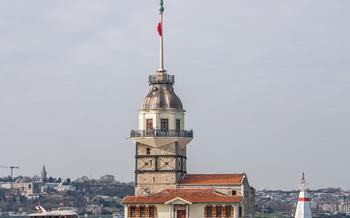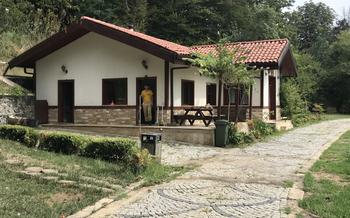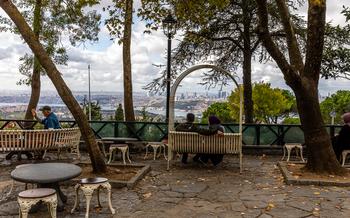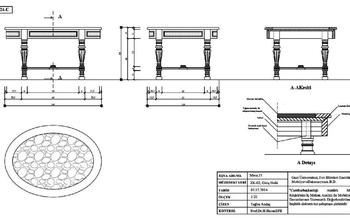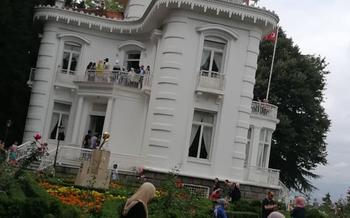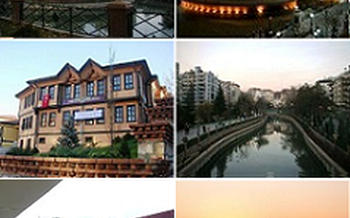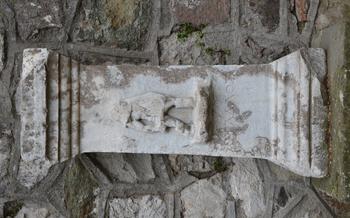
Dolmabahçe Palace
- Dolmabahçe Palace: A Majestic Symbol of Opulence
- A Glimpse into the Ottoman Era
- Exploring the Palace Grounds
- Marveling at the Palace's Architecture
- Delving into the Palace's History
- Admiring the Exquisite Interiors
- Experiencing the Palace's Cultural Significance
- Touring the Palace's State Rooms
- Admiring the Palace's Art Collection
- Learning about the Palace's Restoration
- Planning Your Visit to Dolmabahçe Palace
- Capturing the Palace's Beauty
- Insider Tip: Unveiling the Secret Garden
Dolmabahçe Palace: A Majestic Symbol of Opulence
Situated on the enchanting shores of the Bosphorus Strait, Dolmabahçe Palace stands as a testament to the grandeur and opulence of the Ottoman Empire. Constructed in the mid-19th century under the reign of Sultan Abdülmecid I, this magnificent palace served as the administrative center and the final residence of six Ottoman sultans. Its strategic location, overlooking the waterway that connects the Black Sea to the Sea of Marmara, highlights its significance as a symbol of imperial power and prestige.
With its breathtaking views of the Bosphorus, Dolmabahçe Palace captivates visitors with its architectural marvels and exquisite interiors. The palace boasts a harmonious blend of Ottoman, Baroque, and Neoclassical styles, adorned with intricate details, ornate decorations, and lavish furnishings. Its grand entrance, featuring imposing gates and a sweeping courtyard, sets the stage for an awe-inspiring journey into the opulent world of the Ottoman sultans.
The Hall of Ceremonies, the heart of the palace, stands as a masterpiece of design and craftsmanship. Its soaring ceilings, adorned with intricate chandeliers and opulent paintings, create a sense of grandeur that befits the palace's status as the center of imperial power. Each room within Dolmabahçe Palace tells a story of opulence and extravagance, showcasing the finest materials and craftsmanship of the era.
A Glimpse into the Ottoman Era
The grandeur of the Ottoman Empire unfolds within the walls of Dolmabahçe Palace as it once served as the administrative center and the final residence of six Ottoman sultans. These sultans ruled over a vast empire that stretched across three continents and left an indelible mark on world history. Witness the opulent settings where momentous decisions were made, alliances were forged, and the fate of nations was shaped. Dolmabahçe Palace stands as a testament to the empire's grandeur, wealth, and power, providing a glimpse into the lavish lifestyle and extravagance of its rulers.
Exploring the Palace Grounds
Dolmabahçe Palace is not just a magnificent architectural marvel; it also boasts sprawling grounds that offer a tranquil escape from the bustling city. As you step out of the opulent interiors, you are greeted by meticulously manicured lawns, vibrant flower beds, and towering trees that create a serene atmosphere. Take a leisurely stroll along the garden paths, inhaling the sweet fragrance of roses and jasmine.
At the heart of the gardens lies the breathtaking Bosphorus Strait, which offers panoramic views that will leave you spellbound. Admire the sparkling waters, the passing ships, and the distant skyline of Istanbul, which creates a picturesque backdrop for your exploration. Whether you choose to bask in the sun, enjoy a picnic under the shade of a tree, or simply relax and soak in the tranquility of the surroundings, the palace gardens offer a perfect sanctuary for rejuvenation and contemplation.
Don't miss the iconic Clock Tower, a prominent landmark that stands proudly within the palace grounds. With its intricate details and imposing presence, the tower serves as a reminder of the palace's rich history and architectural grandeur. Take a moment to appreciate the craftsmanship and marvel at the precision of the clock, which has been keeping time for over a century.
Marveling at the Palace's Architecture
The architectural grandeur of Dolmabahçe Palace reflects a harmonious fusion of Ottoman, Baroque, and Neoclassical styles. Intricate details and ornate decorations adorn every corner, showcasing the exceptional craftsmanship of the era. The palace's imposing gates provide a grand entrance, leading visitors into a world of opulent splendor. Among the architectural highlights, the Hall of Ceremonies stands out as a masterpiece of design. Its soaring dome, intricate chandeliers, and exquisite wall paintings create an awe-inspiring ambiance fit for grand receptions and ceremonies.
Delving into the Palace's History
The construction of Dolmabahçe Palace began in 1843 under the reign of Sultan Abdülmecid I, who sought to create a lavish residence that would rival the grandeur of the Topkapi Palace. The palace's construction was a massive undertaking, involving thousands of workers and craftsmen, and was completed in 1856 at a staggering cost.
During the Crimean War (1853-1856), Dolmabahçe Palace served as the headquarters of the Ottoman army and was the stage for important military decisions. The palace also witnessed the abdication of Sultan Abdülhamid II in 1909, marking the end of the Ottoman Empire.
In 1922, following the Turkish War of Independence, Dolmabahçe Palace became the official residence of Mustafa Kemal Atatürk, the founder of the Turkish Republic. Atatürk spent his final years in the palace and died there in 193
The declaration of the Turkish Republic in 1923 was a pivotal moment in the history of Dolmabahçe Palace, as it transformed the palace from a symbol of the Ottoman Empire to a symbol of the new Turkish state. The palace's opulent interiors and grand architecture were preserved and restored, and it was opened to the public as a museum in 198
Today, Dolmabahçe Palace stands as a testament to the grandeur and legacy of the Ottoman Empire and is a must-visit destination for anyone interested in Turkish history, culture, and architecture.
Admiring the Exquisite Interiors
Dolmabahçe Palace boasts an interior that is as awe-inspiring as its exterior. Every room is adorned with intricate details and opulent furnishings, reflecting the lavish lifestyle of the Ottoman sultans. Lavish chandeliers hang from the ceilings, casting a warm glow on the gleaming marble floors. Crystal staircases and marble fireplaces add to the grandeur of the palace's interior.
Among the most stunning rooms in the palace is the Crystal Hall, a magnificent reception room that was used for grand events and ceremonies. Its walls are adorned with thousands of crystals, reflecting the light from the massive chandeliers and creating a dazzling display. The room's high ceiling is supported by slender columns, giving it an air of spaciousness and elegance.
Another highlight of the palace's interior is the Harem, the private quarters of the sultan's family. This secluded section of the palace is adorned with intricate tilework, colorful carpets, and ornate mirrors. The rooms are smaller and more intimate, creating a sense of coziness and privacy. The Valide Sultan's Chamber, the residence of the mother of the sultan, is particularly impressive, with its elegant furnishings and stunning views of the Bosphorus.
Experiencing the Palace's Cultural Significance
Dolmabahçe Palace stands as a symbol of Turkish heritage and national pride, a testament to the country's rich and storied past. Its significance extends beyond its architectural and historical importance, as it has become a beloved destination for both locals and tourists alike. The palace serves as a venue for cultural events and exhibitions, showcasing Turkey's vibrant arts and cultural scene. Through these initiatives, Dolmabahçe Palace plays a crucial role in preserving and promoting Turkish heritage, ensuring that the legacy of the Ottoman Empire continues to inspire and captivate generations to come. Every year, millions of visitors from around the world flock to this magnificent palace, eager to immerse themselves in its grandeur and experience the cultural tapestry that it represents.
Touring the Palace's State Rooms
The Dolmabahçe Palace boasts an array of opulent state rooms, each serving a specific purpose in the official functions of the Ottoman Empire. The Throne Room, the heart of the palace, exudes grandeur with its ornate throne, crystal chandeliers, and intricate ceiling frescoes. Here, the sultan received foreign dignitaries, held official ceremonies, and conducted state affairs.
The Blue Room, a testament to the empire's diplomatic prowess, was used to welcome and entertain distinguished guests. Its walls adorned with blue silk and intricate gold embroidery, along with stunning views of the Bosphorus, created an awe-inspiring setting for diplomatic gatherings.
The Pink Room, a more intimate space, served as the sultan's private sitting room. Decorated in shades of pink and gold, with delicate floral motifs and plush furnishings, it offered the sultan a tranquil retreat from the rigors of his official duties.
Finally, the Yellow Room, with its vibrant yellow walls and stunning views of the gardens, was the designated dining room for the sultan and his guests. The room's crystal chandeliers, opulent furniture, and exquisite table settings reflected the lavish lifestyle of the Ottoman court.
Admiring the Palace's Art Collection
Dolmabahçe Palace houses an impressive art collection that reflects the eclectic tastes of the Ottoman sultans. The collection includes a diverse range of paintings, sculptures, and artifacts, showcasing both Turkish and European influences. Visitors can admire works by renowned Turkish artists such as Osman Hamdi Bey and Şeker Ahmet Paşa, as well as European masters like Eugène Delacroix and Ivan Aivazovsky. The Portrait Gallery is a highlight, featuring portraits of Ottoman rulers from different eras, offering a glimpse into the personalities and legacies of these powerful figures. The palace's art collection not only adds to its aesthetic splendor but also provides valuable insights into the cultural and artistic heritage of the Ottoman Empire.
Learning about the Palace's Restoration
In recent years, Dolmabahçe Palace has undergone extensive restoration efforts to preserve its historical integrity and transform it into a museum. These efforts involved meticulous attention to detail, using traditional techniques and materials to restore the palace to its former glory.
One of the challenges faced during the restoration was the need to balance preservation with modernization. While preserving the palace's original features, modern amenities such as lighting, heating, and security systems were carefully integrated to enhance the visitor experience.
The restoration project also involved the conservation of the palace's vast collection of artifacts, including furniture, paintings, and textiles. These items were carefully restored to their original condition, providing visitors with a glimpse into the opulent lifestyle of the Ottoman sultans.
The successful completion of the restoration project has resulted in the reopening of Dolmabahçe Palace to the public. Today, visitors can marvel at the palace's grandeur and learn about its rich history, thanks to the dedication and expertise of the restoration team.
Planning Your Visit to Dolmabahçe Palace
To ensure a seamless and enriching experience, planning your visit to Dolmabahçe Palace is essential. The palace is open to the public daily, except on Mondays, from 9 am to 4 pm. Ticket prices vary depending on the season and whether you opt for a guided tour or an audio guide. Guided tours are highly recommended, as they provide valuable insights into the palace's history and architecture.
Once inside, don't miss the opportunity to explore the palace's extensive gardens. Take a leisurely stroll along the manicured lawns, admire the vibrant flower beds, and soak in the breathtaking views of the Bosphorus Strait. The Clock Tower, a prominent landmark within the palace grounds, offers a unique perspective and is worth a visit.
For a convenient and hassle-free experience, consider booking your tickets online in advance. This will allow you to skip the queues and ensure your entry during peak tourist seasons. Remember to wear comfortable shoes, as you'll be doing a fair amount of walking during your visit.
Facilities such as cloakrooms, cafes, and restrooms are available within the palace grounds, catering to the needs of visitors. So, whether you're a history buff, an architecture enthusiast, or simply seeking a glimpse into the grandeur of the Ottoman Empire, Dolmabahçe Palace is a must-visit destination in Istanbul.
Capturing the Palace's Beauty
The grandeur of Dolmabahçe Palace demands to be captured in photographs. Here are some tips for capturing the palace's beauty through your lens:
-
Choose the right angle: Stand at a distance to capture the palace's full scale and majesty. Experiment with different angles to find the most flattering perspective.
-
Consider the lighting: The palace looks stunning in both daylight and twilight. For warm and golden shots, visit during sunrise or sunset. For dramatic silhouettes, shoot against the backdrop of a clear night sky.
-
Use a tripod: A tripod will help stabilize your camera, especially for long-exposure shots. This will minimize blur and ensure sharp images.
-
Respect the palace's rules and regulations: Flash photography is prohibited inside the palace. Be mindful of other visitors and keep your voice low while taking photos.
Insider Tip: Unveiling the Secret Garden
Amidst the grandeur and opulence of Dolmabahçe Palace lies a hidden gem: the Secret Garden. Nestled away from the main tourist routes, this serene oasis offers a tranquil escape from the bustling palace grounds.
Enter through a discreet doorway and step into a world of lush greenery, vibrant flowers, and the gentle sound of water fountains. Wander along winding paths that lead you through manicured lawns, past blooming rose bushes, and under the shade of towering trees.
Discover hidden nooks and secluded corners where you can relax and soak in the tranquility of the garden. Enjoy a picnic surrounded by nature's beauty, or simply sit on a bench and let the world melt away as you listen to the birds singing.
The Secret Garden is a perfect spot to escape the crowds and find a moment of peace and tranquility. Whether you're a nature lover, a history buff, or simply seeking a quiet retreat, this hidden gem is sure to captivate your senses and leave you with lasting memories of your visit to Dolmabahçe Palace.


